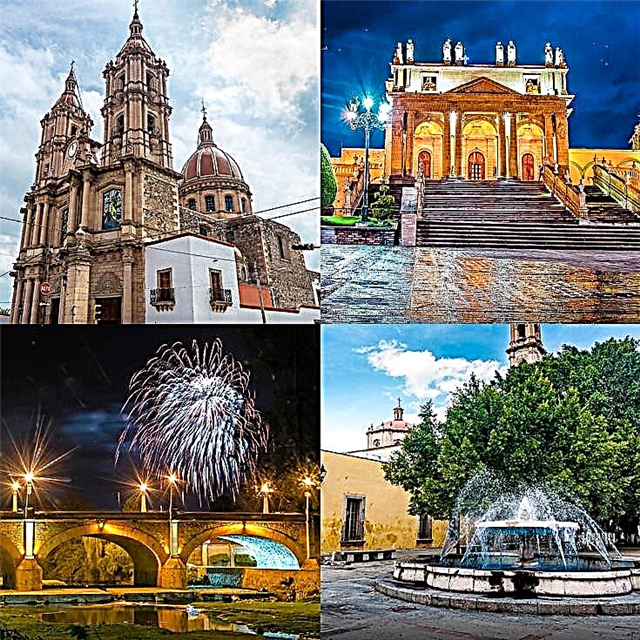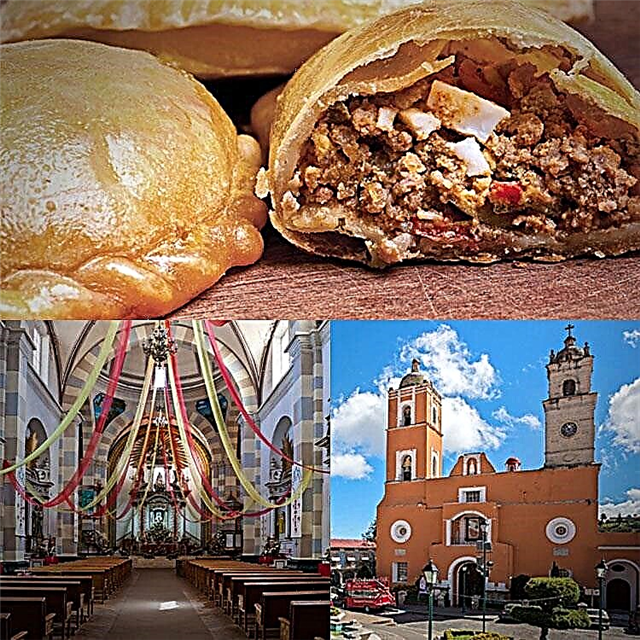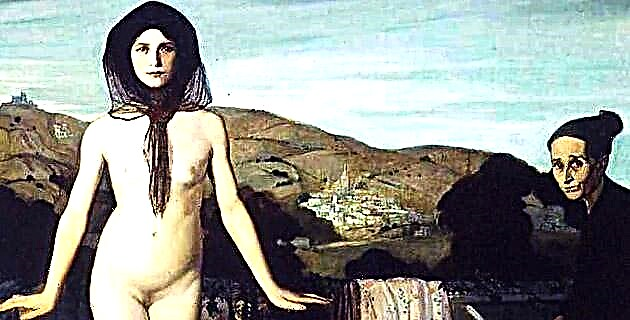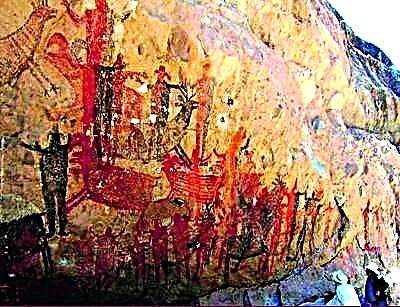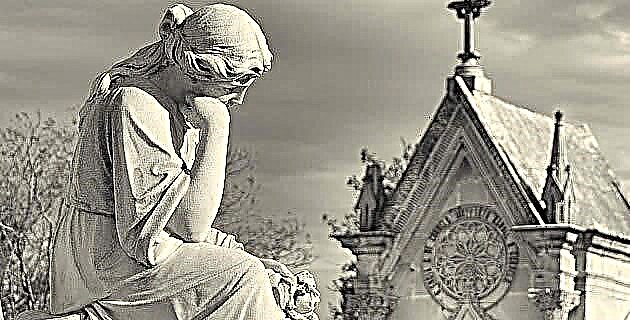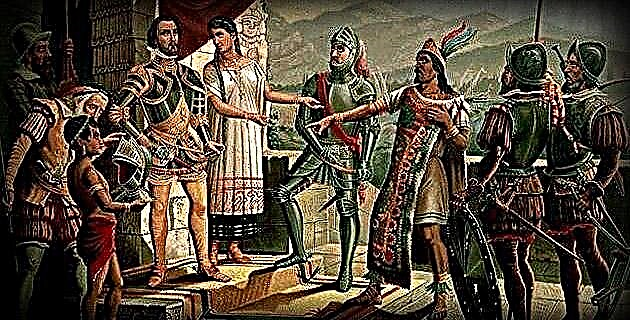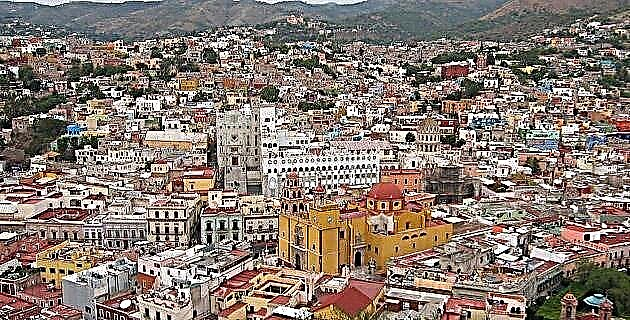
In one of the narrowest canyons of the Sierra de Santa Rosa, on the northern limit of the fertile lands of the Bajío, the unusual city of Guanajuato emerges, as if by some enchantment.
In one of the narrowest canyons of the Sierra de Santa Rosa, on the northern limit of the fertile lands of the Bajío, the unusual city of Guanajuato emerges, as if by some enchantment. Its buildings seem to cling to the slopes of the hills and hang from the high alicantos of its underground streets. Crowded together along narrow and twisting alleys, they are silent witnesses to the great silver bonanzas that made this settlement the world's leading producer. In the past, its hills were covered by a dense oak forest and its streams populated by willows or pirules; In this Sierra the ancient settlers-Guamares and Otomí Indians-hunted deer and hares, calling this region with several names: Motil, “Place of metals”; Quanaxhuato “Mountainous place of frogs”, and Paxtitlan, “Where the paxtle or hay abounds”.
Like many of the lands that made up the territory of the Great Chichimeca, the Guanajuato region was colonized in the 16th century under the form of cattle ranches, granted to Rodrigo de Vázquez, Andrés López de Céspedes and Juanes de Garnica after 1533, year in which San Miguel el Grande was founded for the first time - today from Allende. Towards the second half of that century, the rancher Juan de Jasso discovered some silver minerals that were reported in Yuririapúndaro; As of that moment and the subsequent discoveries of the Rayas and Mellado mines, as well as the famous mother vein that is the one that feeds the majority of the deposits in the Sierra, the economy undergoes a severe transformation when leaving the cattle ranching. as a dominant activity and substantially become a mining company. This radical turn led to colonization by gambusinos and adventurers, who, due to the obvious need for a water supply, preferred the bed of the ravines for their homes.
One of the first chroniclers of the city, Lucio Marmolejo, refers that as an immediate consequence of this incipient town and for the protection of mining activities, four forts or Royal Mines had to be formed: that of Santiago, in Marfil; that of Santa Fe, on the slopes of Cerro del Cuarto; that of Santa Ana, deep in the Sierra, and that of Tepetapa. In the original planning, according to Marmolejo, the Real de Santa Ana was destined to be the head of said forts; However, it was the Real de Santa Fe, the most prosperous, which marked the origin of the current city. It is the date of 1554 that is taken as the starting point of this settlement called to be the richest in New Spain.
Guanajuato had to face serious difficulties for its development since then, since the territory did not offer the necessary topographical conditions to allow the reticular layout imposed by Felipe II. In this way, the narrow ravine forced the village to be arranged irregularly according to the usable slopes of the land, forming the winding alleys broken by the hills that give it its picturesque appearance of the trace of a broken plate to this day. Of these first constructions of the 16th century, only the chapels of the Indian hospitals remain, much modified today.
Time continued its implacable career and saw the activities of the establishment develop favorably, which in 1679 received from Carlos II the title of Villa. As a result of this distinction, some of its neighbors gave part of their properties to create the Plaza Mayor de Ia Villa -today Plaza de Ia Paz-, thus taking the first steps for the development of the settlement. On this primitive line the site was adapted to erect the parish of Nuestra Señora de Guanajuato - currently the Collegiate Basilica - and a few rods upriver, that of the first convent of the population: San Diego de Alcalá. At the end of the seventeenth century the main streets were already outlined and the urban district was perfectly established according to the productive activities: mining extraction was concentrated in the high points of the mountain range, the benefit of metal was made in the farms located on the bed of the river. cañada, where in addition the places of medical and devotional attention were distributed, as well as the places of residence for the workers. In the same way, the necessary inputs for the exploitation and maintenance of the miners were assured by the inexhaustible forests of the Sierra and by the entire agricultural-livestock apparatus of the Bajío promoted by the owners of the mines themselves. On these solid foundations, the 18th century -marked forever by wealth and contrasts- had to witness, without a doubt, the greatest splendor that placed Guanajuato as the first silver producer in the known world, far surpassing its sister Zacatecas and to the mythical Potosí in the Viceroyalty of Peru, as repeatedly stated by the Baron de Humboldt in his "Political Essay on the Kingdom of New Spain."
The first half of this transcendental century began to show the latent wealth of the place, expressed in a first construction fever. Among them, the important hospital complex of Our Lady of Belén and the Calzada and Sanctuary of Guadalupe stand out. This incipient boom was witness in 1741 of the ascension that the Villa had to the title of City by the hands of Felipe V, due to the abundant yields of its mines. Thus, the Very Noble and Very Loyal City of Santa Fe, Real and Minas de Guanajuato woke up very late - in the last century of the Viceroyalty - to hastily fulfill the great destiny that had been marked for it.
At that time it only remained for the great silver boom to emerge, long awaited by Guanajuato. Although the Mina de Rayas, very rich due to its high grade, and its neighbor, Mellado, had already generated abundant wealth and the first two noble titles for Guanajuato -Ios Marquesados de San Juan de Rayas and San Clemente-, was the Mina de Valenciana The one that succeeded in placing the city at the top of the silver centers of the world. Rediscovered in 1760, it was sufficiently productive to generate not only three new Counties -of Valenciana, Casa RuI and Pérez Gálvez-, but the construction of a plethora of new buildings, such as the temple of the Company of Jesus, the Presa de Ia Olla, the church of Belén, the temple and convent of San Cayetano de Valenciana and the dominant Casa Mercedaria de Mellado built in the second half of the 18th century.
Its underground streets, one of the most characteristic features of Guanajuato, date back to the end of that century and are the product of a unique relationship in America between the inhabitants and water. This singularity is based on a cosmogonic duality of generation and destruction, unitary and indivisible: the city agreed to its birth with the river of the canyon; This supplied it with the liquid necessary for its activities and survival, but it also threatened it with devastation and death. During the eighteenth century, seven terrible floods swept the city with the force of the torrent, destroying houses, temples and avenues, disasters mainly due to the fact that the settlement was displaced from the same level as the river bed, and the river was too clogged by debris. of the mines, he could not contain the furious volume of the liquid in the rainy season. As a result of the fateful flood of 1760, the public conscience was awakened to remedy these serious problems. One of the solutions proposed was to enclose the riverbed with strong cliffs a little less than 10 m high in the entire urban perimeter of the stream. The titanic work involved modifying the original level of Guanajuato and burying large portions of the city for that purpose, re-leveling the land and building on the old buildings, for which a wave of rejections and protests arose from the inhabitants who feared for the disappearance of their dwellings and goods. Finally, it was postponed due to the costly and complex nature of its implementation. However, the implacable destiny would not allow much time to pass, as one more misfortune, the great flood of 1780, left again desolation and death in its wake and forced the execution of these works, thus beginning with the first change in level suffered. through the city at the point where the current was causing the most damage: the convent of San Diego de Alcalá.
In this way, the population saw the entire convent with its four chapels and its main church, the atrium and the Dieguino square, the houses and the surrounding streets buried. When the work was completed in 1784, the new temple gained dimensions in length and height, as well as a beautiful octagonal sacristy and its Rococo façade; The convent and its chapels were reopened and the square - which over the years would become the Jardin de la Unión manor - was opened for the social activities of the inhabitants.
Once the first correction of the city levels was concluded, the following disasters occurred in the last decade of that century and throughout the following century, which marked the settlement for the rest of its existence: the 18th-century Baroque city was buried, preserving only a few constructions in the high and hierarchical urban points. For this reason the formal aspect of Guanajuato is generally neoclassical. The abundant existence of capital in the first decades of the 19th century was manifested in the reconstruction of the buildings and the renovation of their facades. This image persists to this day because, contrary to what happened with its neighbors León, Celaya and Acámbaro, in the 20th century there was not enough wealth in the city to “modernize” it, preserving, for the good of all, its incorrectly Called colonial look.
The history of the nineteenth century is as important for Guanajuato as the splendid viceregal period: the first of its decades was abundant in wealth and opulence, which the birth of the neoclassical was able to take advantage of for the creation of magnificent exponents, such as the Palacio Condal de Casa RuI. and the transcendent Alhóndiga de Granaditas. It was in this building where priest Miguel Hidalgo with a host of miners and peasants defeated the peninsular, thus obtaining the independence revolution its first great triumph. The participation of a miner nicknamed “EI Pípila,” who opened the way for the insurgents to the interior of the Alhóndiga, was of vital relevance; Although this character was recently eliminated from the history books, he is a true symbol of the fight for freedom of the Guanajuato people: his courage turned into a stone myth, he guards the future of the city from the Cerro de San Miguel.
Despite the indisputable benefits that Independence brought to the nation, the immediate effects were disastrous for Guanajuato. The opulent city and its mines were seriously damaged in its economy: almost no ore was produced, the beneficiation farms were abandoned and destroyed, and inputs were scarce in the region. Only Lucas Alamán provides a solution to reactivate economic movements by promoting the creation of mining companies with English capital. Subsequently, after the triumph of Porfirio Díaz, the foundation of foreign corporations was once again promoted, which gave the city yet another bonanza, reflected in the construction of the palaces of the refined Paseo de Ia Presa, as well as in the sumptuous buildings of the Porfiriato that have Guanajuato has been given international fame: the eclectic Teatro Juárez, one of the most beautiful in the Republic, unfortunately located on the mines of the Dieguino convent; the Palace of Congress and the Monument to Peace in the Plaza Mayor, as well as the large metal building of the Hidalgo Market.
The historical cycle closes again in Guanajuato; having reached another silver bonanza, the armed movements disintegrate the peace and social stability of the Republic. The Revolution of 1910 passed through this city, driving away foreign investors, a situation that, together with the economic depression and the fall in silver prices, led to the abandonment of the mining facilities and a large part of the settlement in general. running the danger of disappearing and becoming another ghost town, like so many others in the corners of the national territory.
The recovery was due to the willpower of some men who put all their talent to the good of the revival of the place. Great works impute and defend the seat of the State Powers; Both periods of Government build the current building of the Autonomous University of Guanajuato - unequivocal symbol of the population - and unblock the river bed - flooded by level changes in the eighteenth and nineteenth centuries - for the creation of a vehicular artery that decongests the incipient automobile traffic: the Miguel Hidalgo underground street.
Recently, as a well-deserved wake-up call, the Declaration of the City of Guanajuato as a World Heritage Site directed its gaze towards the historical monuments, which, including their adjacent mines, rose to the aforementioned rank. As of 1988 Guanajuato was inscribed, with number 482, on the UNESCO World Heritage List, which includes the richest cities in cultural matters. This fact has influenced Guanajuatenses to further revalue their monumental heritage.
The public conscience of the population has been awakened with the knowledge that preserving the past for the future is one of the tasks that will be appreciated by subsequent generations. A large number of religious and civil buildings have been restored and reconditioned by their owners, bringing to light again a considerable part of the splendor obtained by the city.
With the creation of civil groups that have taken this urgent task as their own, the rescue of movable property owned by the nation has been promoted, represented by the rich pictorial collections of Guanajuato temples, their ornaments and accessories: all the tubular organs of the Viceroyalty located in the settlement were restored and put into service, in addition to having rescued approximately 80 beginnings of the temple of the Society of Jesus and 25 of the San Diego, which, already restored, were placed within the same temples in a specific area. designed to prevent damage and deterioration. These actions were possible thanks to a joint effort of the members of society and the public powers: private organizations such as Guanajuato Patrimonio de Ia Humanidad, A.C. and other committed citizens, and the State Government, the Secretariat of Social Development and the University of Guanajuato.
The preservation of the cultural manifestations of the rich history of the city will allow us to show in the future the times of the great bonanzas of the mining district, its splendid periods of wealth and its economic transitions.
The opulent development of the historical development of Guanajuato remains reflected not only in the documents, but also in the memory and conscience of its inhabitants, who are known to be depositories of a monumental legacy and of the responsibility for the rescue of these buildings and movable property, now the patrimony of all humanity.

